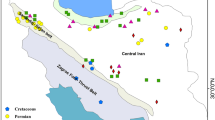Abstract
In an area of marginal farming, trace element distribution associated with lead, fluorite and baryte mineralization is important to the farmer because of the high infertility rate of the livestock and contamination of plant produce leading to the subsequent failure of the farming economy. Therefore sampling of superficial sediments was undertaken over the mineralized Carboniferous Limestone of North Derbyshire above the medieval lead and the modern fluorite workings. Twenty-seven elements were analyzed using emission spectrophotometry and subsequently compared with the geochemistry of the underlying bedrock. Discrepancies which occur are attributed to the glacial and periglacial action during the Wolstonian and Devensian glacial episodes.
Similar content being viewed by others
References
Burek, C. V. Quaternary deposits on the Carboniferous Limestone of Derbyshire. Unpublished Ph.D. Thesis, Univ. of Leicester, 1978, 509 pp.
Ford, T. D. Limestones & Caves of the Peak District. Geobooks, Norwich, England, 1977, 469 pp.
Johnson, P. A. Soils in Derbyshire.Soil Survey Record, 4, 1971, 100 pp.
Boulter, M. C., Ford, T. D., Ijtaba, M. &Walsh, P. T. The Brassington formation, a newly recognized Tertiary formation of the southern Pennines.Nature Phys. Sci., 231(23), 1971, 134–136.
Walsh, P. T., Boulter, M. C., Ijtaba, M. &Urbani, D. M. The preservation of the Neogene Brassington Formation of the southern Pennines and its bearing on the evolution of Upland Britain.J. Geol. Soc., 128, 1972, 519–559.
Worley, N. E. &Ford, T. D. Minerals and Mines. In Ford, T. D. (Ed)Limestones and caves of the Peak District, Geobooks, Norwich, England 1977, 143–165.
Ford, T. D. The stratiform ore deposits of Derbyshire. In James, C. E. (Ed)Sedimentary ores ancient and modern revised (Proc. Inter. Univ. Geol. Congress. Leicester 1965), 1969, 73–96.
Butcher, N. J. D. &Ford, T. D. Geological structure. In Ford, T. D. (Ed)Limestones and caves of the Peak District, Geobooks, Norwich, England, 1977, 129–141.
Pigott, C. D. Soil formation and development on the Carboniferous limestone of Derbyshire. Parent material.J. Ecol., 50, 1962, 145–156.
Burek, C. V. The Pleistocene Ice Age and after. In Ford, T. D. (Ed)Limestones and caves of the Peak District, Geobooks, Norwich, England, 1977, 87–128.
Burek, C. V. An unusual occurrence of sands and gravels in Derbyshire.Mercian Geol. 6(2), 1977, 123–130.
Cox, F. C. &Bridge, D. McCl.The limestones and dolomite resources of the country around Monyash, Derbyshire: Description of 1:25,000 resource sheet SK16. Mineral Assessment report 26. IGS, 1977, 138pp.
Nichol, I., Thornton, I., Webb, J. S., Fletcher, W. K., Horsnail, R. F., Khaleelee, J. &Taylor, G. Regional geochemical reconnaissance of the Derbyshire area. Report no. 70/2, 1970, 37pp.
Ineson, P. R. Trace element aureoles in limestone wallrocks adjacent to lead-zinc-barite-fluorite mineralization in the northern Pennines and Derbyshire ore field.Trans. Inst. Min. Metall., 78, 1969, B 29–40.
Stevenson, I. P. &Saunts, G. D. Geology of the country around Chapel en le Frith. Memoir. Geol. Surv. Great Britain, 1971, 444pp.
Sabine, P. A., Guppy, E. M. &Sergeant, G. A. Geochemistry of sedimentary rocks (1) Petrography and chemistry of arenaceous rocks.Inst. Geol. Sci., report no. 69/1, 1969, 68pp.
Taylor, D., Nichol, I. &Webb, J. S. Enrichment of base metals in the Triassic sandstones of southern Derbyshire.Trans. Inst. Min. Metall., 76 B214–5.
Colburn, P. &Thornton, I. Lead pollution in agricultural soils.J. Soil Sci. 29(4), 1978, 513–526.
Davis, J. C. Statistics and data analysis in geology. John Wiley, 1973, 550pp.
Sampson, R. J. Surface II graphics system. Kansas Geological Survey series on spatial analysis, no. 1, 1975, 240pp.
Aubert, H. &Pinta, M. Trace elements in soils. Developments in Soil Science1, Elsevier, 1977, 395pp.
Evans, H. J. Role of molybdenum in plant nutrition.Soil Sci. 81, 1956, 199–208.
Cannon, H. L. &Hopps, H. C. Geochemical environment in relation to health and disease.Geol. Soc. Amer. Special Paper 140, 1972, 77pp.
Mitchell, R. L. Trace elements in soils. In Bear, F. E. (Ed)Chemistry of the soil. Reinhold Publishing Co. 1964, 320–368.
Davies, E. B. Factors affecting molybdenum availability in soils.Soil Sci. 81(3), 1956, 209–221.
Author information
Authors and Affiliations
Rights and permissions
About this article
Cite this article
Burek, C.V., Cubitt, J.M. Trace element distribution in the superficial deposits of Northern Derbyshire, England. Minerals and the Environment 1, 90–100 (1979). https://doi.org/10.1007/BF02001233
Issue Date:
DOI: https://doi.org/10.1007/BF02001233




